Organizational Communication 组织传播学
传播学术语中英对照

人内传播:intra-personal communication 自我互动:self interaction象征符:symbol内省式思考:reflective thinking人际传播:personal communication集合行为:collective behavior乌合之众:crowd流言:rumor意见领袖:opinion leader两级传播:two step flow of communication 中介因素:mediating factors信息流:information flow影响流:influencing flow知沟:knowledge gap数字鸿沟:digital gap可信性:credibility专业权威性:expertness休眠效果(霍夫兰):sleeper effect诉诸理性:rational persuasion诉诸情感:emotional persuasion显著性:salience自信心假说:self-confidence hypothesis议程设置功能:the agenda-setting function:McCombs&Show What is the agenda-setting function:Media concentration on a few issues and subjects leads the public to perceive those issues as more important than other issues. That is,if a news item is covered frequently and prominently,the audience will regard the issue as more important.属性议程设置:attributes agenda-setting沉默的螺旋:the spiral of silence社会合意:social consensus意见气候:opinion climate中坚分子:the hard core培养分析:cultivation analysis故事讲解员:story-teller熔炉:melting-pot新闻框架:news frameNews frame的四种功能:Problem definition(提供问题定义);causal interpretation(阐释事件原因);moral evaluation(提供道德评价);treatment recommendation(示意解决方案)上限效果(ceiling effect)假说;信息富有者(information-rich)信息贫困者(information-poor)媒介素养(media literacy)第三人效果(the third-person effect)拉斯韦尔:Lasswell卢因:Lewin霍夫兰:Hovland拉扎斯菲尔德:Lazarsfeld施拉姆:Schramm香农:Shannon威纳:Norbert Wiener经验学派:empirical school批判学派:critical school霸权:hegemony文化帝国主义:cultural imperialism文本解析:text analysis美国源流:杜威(Dewey)库利(Cooley)提出两个概念:一是初级群体(primary group)二是镜中我(looking-glass self)帕克(Park)米德(Mead):主我(I)和客我(Me)对理解人内传播很有意义李普曼(Lippmann)拟态环境(pseudo-environment)刻板成见(stereotype)拉斯韦尔三功能说:环境监视功能(surveillance of the environment)社会联系与协调功能(correlation of the parts of society)社会遗产传承功能(transmission of social heritage)拉扎斯菲尔德三功能:社会地位赋予功能(status conferral)社会规范强制功能(enforcement of social norms)作为负面功能的“麻醉功能”(narcotizing dysfunction)电子乌托邦(teletopia)多媒体(multi-media)传播制度几种规范理论:集权主义authoritarianism受众权利:传播权(the right to communicate)知晓权(the right to know)媒介接近权(the right of access to mass media)acredited journalist n.特派记者advertisment n.广告advance n.预发消息;预写消息affair(e)n.桃色新闻;绯闻anecdote n.趣闻轶事assignment n.采写任务attribution n.消息出处,消息来源back alley news n.小道消息backgrounding n.新闻背景Bad news travels quickly.坏事传千里。
传播学英文用语

传播Communication内向/自我传播Intrapersonal Communication人际传播Interpersonal Communication群体传播Group Communication 组织传播Organization Communication大众传播Mass Communication单向传播One-Sided Communication双向传播Two-Sided Communication互动传播Interactive Communication媒介Media大众传播媒介Mass Media新媒介New Media新闻洞News Hold新闻价值News Value传播者Communicator主动传播者Active Communicator 受传者/受众/阅听大众Audience 受众兴趣Audience Interest受众行为Audience Activity信息Information信号Signal讯息Message信息熵Entropy冗余/冗余信息Redundancy传播单位Communication Unit奥斯古德模式Osgood Model编码Encoding解码Decoding信源Source传播的数学理论Mathematical Theory of Communication传播渠道Communication Channel 有效传播Effective Communication 传播效果Effects 知识沟Knowledge-Gap使用与满足模式Uses andGratifications Model使用与依从模式Uses andDependencys Model口传系统System of OralCommunication地球村Global Village内爆Implosion全球化Globalization本土化Localization电子空间Cyber Space数字化Digitalization文化帝国主义Culture Imperialism跨文化传播InterculturalCommunication守门人Gatekeeper新闻采集者News Gatherers新闻加工者News Processors模式Model有线效果模式Limited EffectsModel适度效果模式Moderate EffectsModel强大效果模式Powerful EffectsModel子弹论Bullet Theory两级传播模式Two-Step FlowModel多级传播模式Multi-Step FlowModel沉默的螺旋模式Spiral of SilenceModel劝服传播PersuasiveCommunication议程设置模式the Agenda-SettingModel时滞Time Lag最合适效果跨度Optimal EffectsPan时间跨度Time Span公众舆论Public Opinion选择性接触Selective Exposure选择性注意Selective Attention选择性理解Selective Perception选择性记忆Selective Retention可信性提示Credibility Heuristic喜爱提示Liking Heuristic共识提示Consensus Heuristic市场驱动新闻学theMarket-Driven Journalism意识形态Ideology霸权Hegemony权力话语Power Discourse视觉文本Visual Text文本Text超级文本Hypertext结构主义Constructionism解构主义Deconstructionism文化工业Culture Industry大众文化Mass Culture文化研究Cultural Studies批判学派/批判理论Critical Theory法兰克福学派Frankfurt School女权主义/女性主义Feminism符号学Semiotics/Semiology符号Sign能指与所指Signified/Signifier非语言符号Nonverbal Sign非语言传播NonverbalCommunication意指Signification话语理论Theories of Discourse文化期待Culture Expectations文化批判Culture Criticizing范式Paradigm叙事范式Narrative Paradigm强语境High Context弱语境Low Context功能理论Functionalism话语分析Discourse Analysis传播的商品形式the Commodity Forms of Communication受众商品Audience Commodity商品化Commodification空间化Spatialization结构化Structuration媒介集中化Media Conglomeration 传媒产业Media Industry注意力经济Attention Economy媒介竞争Media Competition受众分割Audience Segmentation 媒介资本Media Capital传播政治经济学Political Economy of Communication传播研究Communication Research 抽样Sampling调查研究方法Survey Research内容分析法Content Analysis实验分析法Experimental Research 定性研究法Qualitative Research Methods个案研究法Case Study效度与信度Validity/Reliability变量Variables实地观察法Field Observation虚拟社群Virtual Community扩散研究Diffusion Research媒介事件Media Events民族志Ethnography传播生态Ecology of Communication真实/虚构Reality/Fiction拟态环境Pseudo-Environment刻板成见Stereotyping晕轮效应Halo Effects二元价值评判Two-Valued Evaluation公共关系Public Relation阐释理论Interpretive Theory 第二部分:新闻采编相关词汇daily 日报morning edition 晨报evening edition 晚报quality paper 高级报纸popular paper 大众报纸evening paper 晚报government organ 官报part organ 党报trade paper 商界报纸vernacular paper 本国文报纸political news 政治报纸Newspaper Week 新闻周刊the front page 头版,第一版bulldog edition 晨版article 记事headline 标题banner headline 头号大标题byline 标题下署名之行dateline 日期、发稿地之行big news 头条新闻hot news 最新新闻exclusive news 独家新闻scoop 特讯feature 特写,花絮criticism 评论editorial 社论review, comment 时评book review 书评topicality 时事问题city news 社会新闻column 栏letters 读者投书栏general news column 一般消息栏cartoon, comics 漫画weather forecast 天气预报serial story 新闻小说obituary notice 讣闻public notice 公告advertisement 广告calssified ad 分类广告flash-news 大新闻extra 号外the sports page 运动栏literary criticism 文艺评论Sunday features 周日特刊newsbeat 记者采访地区news blackout 新闻管制press ban 禁止刊行yellow sheet 低俗新闻tabloid 图片版新闻"Braille" edition 点字版newspaper office 报社publisher 发行人proprieter 社长bureau chief, copy chief 总编辑editor-in-chief 总主笔editor 编辑, 主笔newsman, newspaperman, journalist新闻记者cub reporter 初任记者reporter 采访记者war correspondent, campaign badge随军记者columnist 专栏记者star reporter 一流通讯员correspondent 通讯员special correspondent 特派员contributor 投稿家news source 新闻来源informed sources 消息来源newspaper campaign 新闻战free-lancer writer 自由招待会press box 记者席news conference, press conference记者招待会International Press Association 国际新闻协会distribution 发行circulation 发行份数newsstand, kiosk 报摊newspaper agency 报纸代售处newsboy 报童subscription (rate) 报费newsprint 新闻用纸Fleet Street 舰队街accredited journalist n. 特派记者advertisement n.广告advance n.预发消息;预写消息affair n.桃色新闻;绯闻anecdote n.趣闻轶事assignment n.采写任务attribution n. 消息出处,消息来源back alley news 小道消息backgrounding 新闻背景Bad news travels quickly. 坏事传千里。
《组织传播(双语)》课程教学大纲

《组织传播(双语)》课程教学大纲课程编号:12091016课程名称:组织传播(双语)英文名称:Organizational Communication课程类型:专业教育课程课程性质:选修总学时:32 讲课学时:32 实践(实验)学时:0学分:2适用对象:公共事业管理专业先修课程:无一、编写说明(一)制定大纲的依据本大纲依据教育部培养适应公共管理学科和社会发展需要,从事公共管理、企业管理工作,具有组织传播素养和基本技能人才的需求,制定《组织传播(双语)》大纲。
(二)课程简介《组织传播(双语)》课程立足于传播学理论,整合管理学、组织学、社会学、经济学、心理学、文化人类学等诸多学科知识,重点探讨组织环境与传播过程的互动作用,形成符合组织传播现实需要且拥有较大理论发展潜力的理论体系。
通过良好的组织传播,可以促进组织成员对组织共同的目的、利益、价值观念等方面的认同,同心协力地去完成既定任务。
(三)课程的地位与作用地位:《组织传播》是传播学与组织理论研究的交叉领域,在公共事业管理专业本科生培养体系中处于拓展学生公共事业管理与沟通能力的地位。
作用:组织传播作为公共关系管理的一个分支,对于稳定组织成员,应付外部环境,内求团结、外求发展,维护和促进组织的生存和发展都有着重要的作用。
通过本课程的学习,学生可以掌握组织传播的理论知识与技巧,积极有效地开展组织传播活动,进而从公共事务管理与沟通方面实现公共事业管理专业人才的培养目标。
(四)课程性质、目的和任务课程性质:本课程是公共事业管理专业的一门指定选修课。
目的:重点介绍汉语和英语语境下组织传播理论的研究成果,并运用国际化视角考察当前国际上组织传播领域的最新发展状况,帮助学生在组织传播领域确立国际化研究视角和素养,提升他们的组织传播与沟通能力。
任务:通过对英语语境下组织传播文献的学习,培养学生的国际化思维和视野,使他们学习国外组织传播专业英语的同时,能够把握、追踪、反思国内外组织传播发展的最新成果,对该领域形成具有一定分析和鉴别能力的理性认知。
传播学概论-第四讲几种主要的传播类型及传播制度传播媒介

• 群体与组织的区别:
组织实际上是社会群体的一种。
一般来说,判断一个群体是否属于组织, 主要看这个群体中是否有一个统一的指挥 或管理系统,即是否存在着一个“管理主 体”。因此,凡是有中枢指挥或管理系统 的群体,如政党、军队、政府机构、企业、 社团等,都属于组织的范畴。
• 集合行为(collective behavior)是指在某 种刺激条件下发生的非常态社会集合现象, 如火灾、地震后的群众骚乱,出于某种原 因的自发集会、游行、抢购潮等。
• 集合行为发生的三个条件:1,结构性压力, 社会存在不安心理和紧张情绪。2,触发性 事件。3,正常的社会传播系统功能减弱, 流言四起。
• 视频《美人改造计划》
(5)刻板印象stereotype
• 刻板印象,又称为刻板成见,刻板模式,由李普 曼最早提出,是指人们对特定的事物所持的固定 化、简单化的观念和印象,它通常伴随着对该事 物的价值评价和好恶感情。刻板印象可以为人们 认识事物提供简便的参考标准,但也阻碍着对新 事物的接受,因而它起着社会控制的作用。
(4)拟态环境pseudo-environment
• 所谓拟态环境,也称为信息环境,最早由李普曼 提出。该概念指出,媒介现实并非是现实环境的 “镜子式”再现,而是传播媒介通过象征性事件 或信息进行选择和加工,重新加以结构化以后向 人们提示的环境。人们通常意识不到这一点,但 是大众传播形成的信息环境不仅制约人的认知和 行为,而且通过制约人的认知和行为来对客观的 现实环境产生影响。
群体归属意识和群体忠诚度的测验
• 美国传播心理学家凯利和沃卡尔特在1952 年,对中学生的课外团体——童子军进行 的调查问卷,以“野外登山锻炼的态度” 为测试主题。
2第四讲传播类型群体传播与组织传播

小结:
• 群体的意义在于它是个人生 存的初级环境,是社会结构的基 石。
•
群体认同感是群体给予个人以知识 类的信息。
群体归属感给群体中的成员以感情 上的依据
•
群体规范
• 成员个人在群体活动中必须 遵守的法则和体价值。
群体压力
群体中的多数意见对成员中的个 人意见或少数意见所产生的压力。 • 趋同心理、信息压力
趋同心理 也叫做遵从性,指的是个人希望与群 体中多数意见保持一致,避免因孤立而遭 受群体制裁的心理。
产生的原因
•
• •
⑴人天生就有一种对社会孤立的恐惧感, “趋向于一定的群体是人的一种生存方式。
⑵群体为人们的个体行为提供了参照,人 们倾向于相信多数,认为他们是信息的来源而 怀疑自己的判断,因为人们觉得,多数人正确 的机遇多。
• 特点: • 很强的组织性、联系着管理科学和公共 关系。 • 形式:会谈、会议、文件。
组织传播
• 以组织为主体的信息传播活动。
• • • • •
对组织内的传播有三种: A、思想沟通 B、感情沟通 C、工作沟通 (又称角色沟通,如领导与群众之间的 信息交流)
• • • •
对组织外的传播有三种: 一是主义和宗旨的传播 二是发展和扩大组织的传播 三是组织自身形象和政绩的传播
2、组织传播的功能
• • • • 1、内部协调。 2、指挥管理。 3、决策应变。 4、形成共识。
(二)组织传播的特点
• 1、信息大多具有指令性、教导性和劝服性 • 2、组织传播的传播范围总是有限的和有界的 • 3、组织传播活动具有一定的规模
五、大众传播
• (mass communication)
小结:
群体的功能是将自然人变成社会人,并把 个体集合为有序的整体。
第四讲 组织传播
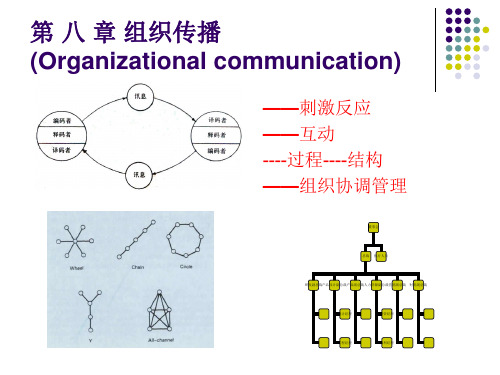
人际关系学派(1930s-): 人际关系学派
霍桑实验→社会因素、管理风格、霍桑效应→管理态度转变,工作 丰富化 家庭隐喻(关心、社会互动、个人成就),关系传播(任务性与维持 性,横向,面对面,非正式)
人力资源学派(1960s-): 人力资源学派
员工思想和观念对组织的智力贡献。 人际关系原则的误用,团队管理,发展和培养人力资源,全面质量 管理, 创新传播(任务、社会与创新,全方位,基本团队,所有渠 道,正式与非正式)
组织的外部传播过程
组织环境:在既定的组织存在的前 提下,由各种机构、团体以及 个人组成的更大范围的环境。 授权型:政府;管理机构;审查; 颁发许可证的单位 功能型:供应商;雇员;职业中 介机构;顾客;财政机构 规范型:贸易协会;行业组织; 竞争者 普通型:当地社区;媒介组织; “一般公众” 和谐平稳/动荡不安; 支持性/敌对 性
第 八 章 组织传播 (Organizational communication)
——刺激反应 ——互动 ----过程----结构 ——组织协调管理
董事会
总裁
执行人员
研发副总裁产品设计副总裁产品副总裁人力资源副总裁营销副总裁 财务副总裁
设计经理
薪资经理
工程经理
福利经理
关于组织的定义
1.古典学派关于组织的定义 组织是以社会职能、职业集团为主要特征,高度结构 化、等级化的正式群体,完成非个人所能进行的目标. 组织的传播学定义: 组织的传播学定义: 组织是一个通过协调活动来达到个人和集体目标的一 个社会集合体(social collectivity)。通过协调活动, 某种程度的组织结构得以建立起来,以帮助组织成员 处理相互之间以及与更大的组织环境中其他人之间的 关系。(米勒)
组织传播-详解

组织传播-详解组织传播(Organizational Communication)目录• 1 什么是组织传播• 2 组织传播的作用• 3 组织传播的类型• 4 组织内部传播的主要形式• 5 组织传播的研究理论[1]• 6 相关条目•7 参考文献什么是组织传播所谓组织传播,就是组织成员之间、组织内部机构之间的信息交流和沟通。
具体地说,组织传播是由各种相互依赖的关系结成的网络,为应付外部环境的不确定性而创造和交流信息的过程。
它的根本任务是清除或减少组织及组织成员对自身环境的不确定性,沟通组织内部的联系。
组织传播的作用在现代社会中,几乎每一个人都在一定的组织内工作和生活,上到国家机关,下至群众团体。
组织沟通是疏通组织内、外渠道,密切组织成员及组织与组织之间关系,完成组织任务最重要的条件之一。
组织传播是公共关系工作的一部分。
通过良好的组织传播,可以促进组织成员对组织共同的目的、利益、价值观念等方面的认同,同心协力地去完成既定任务。
组织传播对于稳定组织成员,应付外部环境,内求团结、外求发展,维护和促进组织的生存和发展都有着重要的作用。
通过组织传播相互交流思想、观念、资料、消息与情感,也是组织成员谋求共同谅解、相互配合的一种方法。
在现代社会中,组织传播开展得如何,对组织既定目标的实现及其发展将产生直接影响。
组织传播是组织活动的源泉。
积极有效地开展组织传播活动,可以使组织各种机制运转正常,保持活力。
同时,组织传播又是组织关系的“黏合剂”,它的直接目的是稳定组织内部成员,协调组织与组织,以及组织成员间的关系,适应各种不同的环境,维持自己的生存和发展。
组织传播的功能对内是协调员工各种认识和行动,优化管理效率;对外是协调、增强与多个相关组织之间的联系或活动,获取目标信息,以及影响社会对组织的认知等。
组织内外的传播功能都是为实现组织目标而发生的。
组织传播在内部通常表现为:下行传播、上行传播、平行传播。
下行传播,是一种管理性质的信息传播,即“上情下达”,是组织传播最基本和最重要的过程。
传播学英语词汇

传播学英语专业词汇传播Communication 内向/自我传播Intrapersonal Communication人际传播Interpersonal Communication 群体传播Group Communication组织传播Organization Communication 大众传播Mass Communication单向传播One-Sided Communication 双向传播Two-Sided Communication互动传播Interactive Communication 媒介Media大众传播媒介Mass Media 新媒介New Media 新闻洞News Hold新闻价值News Value 传播者Communicator 主动传播者Active Communicator 受传者/受众/阅听大众Audience 受众兴趣Audience Interest受众行为Audience Activity 信息Information 信号Signal 讯息Message信息熵Entropy 冗余/冗余信息Redundancy 传播单位Communication Unit奥斯古德模式Osgood Model 编码Encode 解码Decode 信源Source传播的数学理论Mathematical Theory of Communication传播渠道Communication Channel 有效传播Effective Communication传播效果Effects知识沟Knowledge-Gap 使用与满足模式Uses and Gratifications Model使用与依从模式Uses and Dependencys Model 口传系统System of Oral Communication 地球村Global Village 内爆Implosion 全球化Globalization本土化Localization 数字化Digitalization 电子空间Cyber Space文化帝国主义Culture Imperialism 跨文化传播Intercultural Communication守门人Gatekeeper 新闻采集者News Gatherers 新闻加工者News Processors模式Model 有线效果模式Limited Effects Model适度效果模式Moderate Effects Model 强大效果模式Powerful Effects Model子弹论Bullet Theory两级传播模式Two-Step Flow Model 多级传播模式Multi-Step Flow Model沉默的螺旋模式Spiral of Silence Model 劝服传播Persuasive Communication议程设置模式the Agenda-Setting Model 时滞Time Lag最合适效果跨度Optimal Effects Pan 时间跨度Time Span 公众舆论Public Opinion 选择性接触Selective Exposure 选择性注意Selective Attention选择性理解Selective Perception 选择性记忆Selective Retention可信性提示Credibility Heuristic 喜爱提示Liking Heuristic共识提示Consensus Heuristic 意识形态Ideology 霸权Hegemony权力话语Power Discourse 视觉文本Visual Text 文本Text超级文本Hypertext 结构主义Constructionism 解构主义Deconstructionism 文化工业Culture Industry 大众文化Mass Culture 文化研究Cultural Studies 符号学Semiotics/Semiology符号Sign 能指与所指Signified/Signifier 非语言符号Nonverbal Sign非语言传播Nonverbal Communication 意指Signification话语理论Theories of Discourse文化期待Culture Expectations 文化批判Culture Criticizing 范式Paradigm叙事范式Narrative Paradigm 强语境High Context 弱语境Low Context功能理论Functionalism 话语分析Discourse Analysis传播的商品形式the Commodity Forms of Communication 受众商品Audience Commodity 商品化Commodification 空间化Spatialization结构化Structuration媒介集中化Media Conglomeration 传媒产业Media Industry注意力经济Attention Economy 媒介竞争Media Competition传媒英语专业词汇accredited journalist n. 特派记者advertisement n.广告.advance n.预发消息;预写消息affair n.桃色新闻;绯闻attribution n. 消息出处,消息来源back alley news n. 小道消息back grounding n.新闻背景body n. 新闻正文boil vt.压缩(篇幅) box n. 花边新闻brief n. 简讯bulletin n.新闻简报byline n. 署名文章contribution n.(投给报刊的)稿件;投稿contributor n.投稿人copy desk n.新闻编辑部correspondent n.驻外记者;常驻外埠记者cover vt.采访;采写covert coverage 隐性采访;秘密采访daily n.日报dateline n.新闻电头deadline n.截稿时间dig vt.深入采访;追踪(新闻线索);“挖”(新闻) digest n.文摘。
新闻传播学专业词汇英汉对照
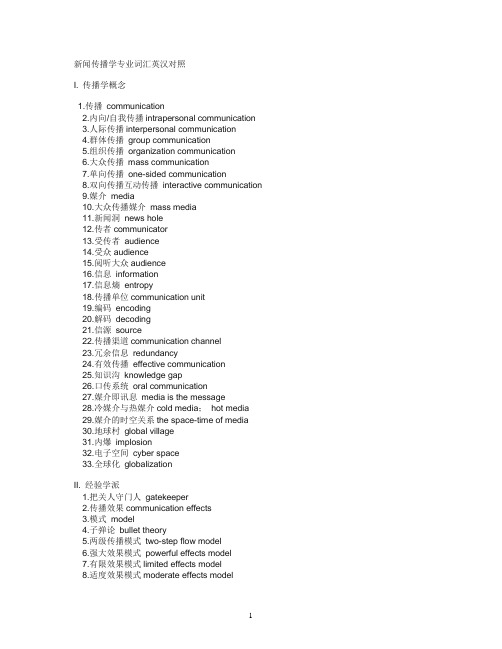
新闻传播学专业词汇英汉对照I. 传播学概念1.传播communication2.内向/自我传播intrapersonal communication3.人际传播interpersonal communication4.群体传播group communication5.组织传播organization communication6.大众传播mass communication7.单向传播one-sided communication8.双向传播互动传播interactive communication9.媒介media10.大众传播媒介mass media11.新闻洞news hole12.传者communicator13.受传者audience14.受众audience15.阅听大众audience16.信息information17.信息熵entropy18.传播单位communication unit19.编码encoding20.解码decoding21.信源source22.传播渠道communication channel23.冗余信息redundancy24.有效传播effective communication25.知识沟knowledge gap26.口传系统oral communication27.媒介即讯息media is the message28.冷媒介与热媒介cold media;hot media29.媒介的时空关系the space-time of media30.地球村global village31.内爆implosion32.电子空间cyber space33.全球化globalizationII. 经验学派1.把关人守门人gatekeeper2.传播效果communication effects3.模式model4.子弹论bullet theory5.两级传播模式two-step flow model6.强大效果模式powerful effects model7.有限效果模式limited effects model8.适度效果模式moderate effects model9.议程设置模式agenda setting model10.时滞time lag11.沉默的螺旋模式spiral of silence12.劝服传播persuasive communication13.拉斯韦尔模式Lasswell’s model14.维纳的《控制论》Wiener’s cybernetics15.传播的数学理论香农一韦弗模式mathematical theory of communication/ Schannon-Weaver’s model16.罗杰斯的创新理论Roger’s innovation theory17.使用与满足模式uses and gratifications model18.使用与依从模式uses and dependency model19.选择性接触选择性注意selective exposure/ selective attention20.选择性理解selective perception21.选择性记忆selective retention22.信源可信度credibility23.高可信度来源high credibility source24.休眠效应sleeper effect25.恐惧诉求fear appeal26.短期效果或长期效果short-term effect/ long-term effect27.报业的四种理论four theories of the pressIII. 批判学派1.意识形态ideology2.视觉文本visual text3.解构主义deconstructionism4.文化工业culture industry5.法兰克福学派Frankfurt School6.霸权hegemony7.权力话语power discourse8.女性主义/女权主义feminism9.符号学semiotics10.非语言符号/非语言传播nonverbal sign/ nonverbal communication11.所指与能指signified/ signifier12.意指siginification13.隐喻与换喻/转喻metaphor14.元语言metalanguage15.话语discourse批评理论critical theory16.话语理论discourse theory17.文化期待culture expectations18.范式paradigm19.叙事范式narrative paradigm20.叙事narrative21.强语境与弱语境high context/ low context22.跨文化传播intercultural communication23.功能理论functionalism24.话语分析discourse analysisIV. 传媒产业1.市场驱动的报纸market-driven newspaper2.传播的商品形式commodity form of communication3.受众商品audience commodity4.媒介集中化media conglomeration5.内在的商品化internal commodity6.传媒产业media industry7.受众分割audience segmentation8.注意力经济attention economy9.媒介竞争competition of media10.媒介资本media capital11.媒介战略管理media strategic management12.媒介集团media conglomeracy13.传播政治经济学political economy of communication V. 传媒研究与方法1.传播研究communication research2.抽样sampling3.调查研究法survey research4.内容分析法content analysis5.实验研究法experiment research6.效度与信度validity/ reliability7.定性研究法qualitative research8.变量variables9.实地观察法field observation10.个案研究法case study11.新媒介new media12.数字化digitalization13.互联网internet14.虚拟社群virtual community博客blog15.扩散研究diffusion study16.短信short message17.数字语言digital language18.超文本hypertext19.媒介事件media event20.媒介仪式media ritual21.传播生态ecology of communication22.对真实的社会建构social construction of reality23.真实/虚构reality / fiction24.拟态环境pseudo-environment25.刻板成见stereotyping26.二元价值观评判two-valued uation27.媒介非中心化decenter the media28.信息社会information society29.媒介功能media function30.公共关系public relation31.阐释理论interpretive theoryVI.人物1.哈罗德•D•拉斯韦尔Harold Dwight Lasswell2.保罗•F•拉扎斯菲尔德Paul F Lazasfeld3.卡尔•I•霍夫兰Carl Iver Hovland4.库尔特•卢因Kurt Lewin5.韦尔伯•L•施拉姆Wilbur Lang Schramm6.马歇尔•麦克卢汉Marshall Mcluhan新闻学I. 著名英文报刊选摘一、美国报纸1、The New York Times 纽约时报2、The Washington Post 华盛顿邮报3、Los Angles Times 洛杉矶时报4、USA Today 今日美国5、The Wall Street Journal 华尔街日报6、The Christian Science Monitor 基督教科学箴言报7、International Herald Tribute 国际先驱论坛报二、美国期刊1.Time 时代2.Newsweek 新闻周刊3.U.S. News and World Report 美国新闻及世界报道4.Reader’s Digest 读者文摘5.Fortune 财富6.Far Eastern Economic Review 远东经济评论三、英国报刊1.The Times 泰晤士报2.Financial Times 金融时报3.The Guardian 卫报4.The Daily Telegraph 每日电讯报5.The Economist 经济学家6.The Spectator 观察家7.New Stateman 新政治家四、其它1、Japan Times 日本时报2、South China Morning Post (HK ) 南华早报(香港)3、China Post (TW) 中国邮报(台湾)4、China Daily (PRC)中国日报(大陆)II. 报纸版面各部分名称1.报耳(ear)2.报头(flag/masterhead/nameplate)3.标题(headline)4.版口(head margin)5.当日新闻提要(index)6.插图(cut)7.图片说明(cutline)8.标题之一行(deck)9.署名(by-line)10.新闻导言(lead)11.引题(kicker)12.头版(frontpage)III 报纸常见栏目名称一、常见新闻栏目1.City / Local / City Edition/ City Page/ Region 城市2.National/ Around The Nation/ Domestic/ Home News 国内新闻3.International / Global 国际新闻4.Brief / In Brief / Briefing / Bulletin 摘要5.Recap 简明新闻6.Pony Report 每日新闻摘要7.Newsline 新闻经纬8.Events And Trends 事件/ 动向9.Exclusive 独家报道10.Expose 新闻曝光11.Issue In The News/ Focus/ Hot News 新闻热点12.Update / Latest News 最新报道13.Feature / News Features / General Features 特写(可囊括除新闻以外的一切报道)mentary / Editorial / Opinion / Column / Letters To The Editors 评论15.Advertisement: Display Advertising / Classified Advertising--- (Jobs/Auto/Real Estate/ For Sale/ Help Wanted) 广告二、常见其他栏目名称1.agony column 答读者问专栏2.anecdote 趣闻轶事3.candid camera 抓拍镜头4.caricature漫画、讽刺画5.cartoon漫画6.chitchat column 闲话栏ic strip 连环漫画8.continued story 连载故事9.correspondence column 读者来信栏10.critique 评论11.crossword 猜字游戏/纵横填字字谜12.digest 文摘13.document 文件摘要14.editor’s note 编者按15.essay杂文、随笔、小品文16.going out guide 旅游指南17.gossip 社会新闻18.how-to-stories 常识指导19.interview 访谈录20.leader社论21.light literature 通俗文学22.mini-torial 短评23.note 随笔24.notice 启事25.obit 讣告26.pegging 新闻背景27.personal / personal column 私人广告/ 人事要闻28.profile 人物专访29.readers’ forum 读者论坛30.review 评论31.round-up综合报道/综述32.running story/ serials 连载故事33.shirttail 社论栏/ 附注34.side story / sidebar / sidelight 花絮新闻/趣闻35.situations vacant / situations wanted 招聘广告36.sponsored section特约专版37.squib小品文/随笔38.strip cartoon / strip 连环漫画/连环画39.Supplement 增刊40.Think piece 时事短评41.Titbit 花絮42.Travelogue/ travels游记43.What’s on 影视指南44.Wise saying 至理名言IV. 常见报纸类型1.daily 日报2.morning edition 晨报3.evening edition 晚报4.quality paper 高级报纸5.popular paper 大众报纸6.evening paper 晚报ernment organ 官报8.part organ 党报9.trade paper 商界报纸10.Chinese paper 中文报纸11.English newspaper 英文报纸12.vernacular paper 本国文报纸13.political news 政治报纸14.Newspaper Week 新闻周刊V. 各类记者名称accredited journalist n. 特派记者publisher 发行人proprieter 社长bureau chief, copy chief 总编辑editor-in-chief 总主笔editor 编辑, 主笔newsman, newspaperman, journalist 新闻记者cub reporter 初任记者reporter 采访记者war correspondent, campaign badge 随军记者columnist 专栏记者star reporter 一流通讯员correspondent 通讯员special correspondent 特派员contributor 投稿家VI 其他bulldog edition 晨版article 记事banner headline 头号大标题big news 头条新闻hot news 最新新闻feature 特写,花絮criticism 评论editorial 社论review, comment 时评book review 书评topicality 时事问题city news 社会新闻general news column 一般消息栏public notice 公告calssified ad 分类广告flash-news 大新闻extra 号外the sports page 运动栏literary criticism 文艺评论Sunday features 周日特刊newsbeat 记者采访地区news blackout 新闻管制press ban 禁止刊行yellow sheet 低俗新闻tabloid 图片版新闻"Braille" edition 点字版newspaper office 报社news source 新闻来源informed sources 消息来源attribution n. 消息出处,消息来源newspaper campaign 新闻战free-lancer writer 自由招待会press box 记者席news conference,press conference 记者招待会International Press Association 国际新闻协会distribution 发行circulation 发行份数newsstand, kiosk 报摊newspaper agency 报纸代售处newsboy 报童subscription (rate) 报费newsprint 新闻用纸Fleet Street 舰队街advance n.预发消息;预写消息affair n.桃色新闻;绯闻assignment n.采写任务back alley news n. 小道消息backgrounding n.新闻背景Bad news travels quickly. 坏事传千里。
传播学英语词汇
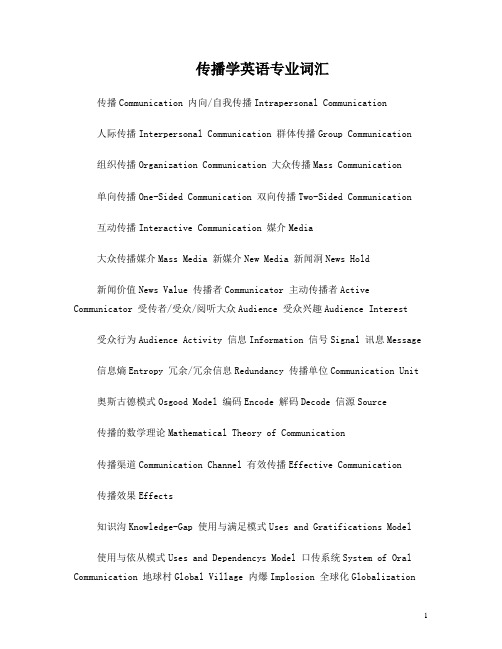
传播学英语专业词汇传播Communication 内向/自我传播Intrapersonal Communication人际传播Interpersonal Communication 群体传播Group Communication组织传播Organization Communication 大众传播Mass Communication单向传播One-Sided Communication 双向传播Two-Sided Communication互动传播Interactive Communication 媒介Media大众传播媒介Mass Media 新媒介New Media 新闻洞News Hold新闻价值News Value 传播者Communicator 主动传播者Active Communicator 受传者/受众/阅听大众Audience 受众兴趣Audience Interest受众行为Audience Activity 信息Information 信号Signal 讯息Message信息熵Entropy 冗余/冗余信息Redundancy 传播单位Communication Unit奥斯古德模式Osgood Model 编码Encode 解码Decode 信源Source传播的数学理论Mathematical Theory of Communication传播渠道Communication Channel 有效传播Effective Communication传播效果Effects知识沟Knowledge-Gap 使用与满足模式Uses and Gratifications Model使用与依从模式Uses and Dependencys Model 口传系统System of Oral Communication 地球村Global Village 内爆Implosion 全球化Globalization本土化Localization 数字化Digitalization 电子空间Cyber Space文化帝国主义Culture Imperialism 跨文化传播Intercultural Communication守门人Gatekeeper 新闻采集者News Gatherers 新闻加工者News Processors模式Model 有线效果模式Limited Effects Model适度效果模式Moderate Effects Model 强大效果模式Powerful Effects Model子弹论Bullet Theory两级传播模式Two-Step Flow Model 多级传播模式Multi-Step Flow Model沉默的螺旋模式Spiral of Silence Model 劝服传播Persuasive Communication议程设置模式the Agenda-Setting Model 时滞Time Lag最合适效果跨度Optimal Effects Pan 时间跨度Time Span 公众舆论Public Opinion 选择性接触Selective Exposure 选择性注意Selective Attention选择性理解Selective Perception 选择性记忆Selective Retention可信性提示Credibility Heuristic 喜爱提示Liking Heuristic共识提示Consensus Heuristic 意识形态Ideology 霸权Hegemony。
传播学复习资料
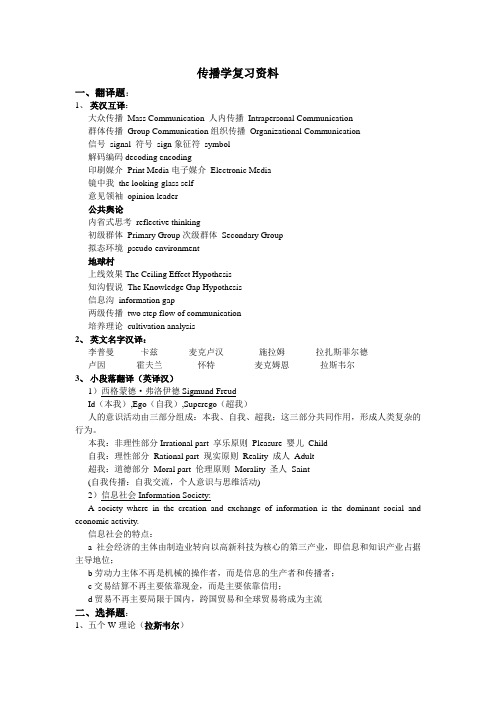
传播学复习资料一、翻译题:1、英汉互译:大众传播Mass Communication 人内传播Intrapersonal Communication群体传播Group Communication组织传播Organizational Communication信号signal 符号sign象征符symbol解码编码decoding encoding印刷媒介Print Media电子媒介Electronic Media镜中我the looking-glass self意见领袖opinion leader公共舆论内省式思考reflective thinking初级群体Primary Group次级群体Secondary Group拟态环境pseudo-environment地球村上线效果The Ceiling Effect Hypothesis知沟假说The Knowledge Gap Hypothesis信息沟information gap两级传播two step flow of communication培养理论cultivation analysis2、英文名字汉译:李普曼卡兹麦克卢汉施拉姆拉扎斯菲尔德卢因霍夫兰怀特麦克姆恩拉斯韦尔3、小段落翻译(英译汉)1)西格蒙德·弗洛伊德Sigmund FreudId(本我),Ego(自我),Superego(超我)人的意识活动由三部分组成:本我、自我、超我;这三部分共同作用,形成人类复杂的行为。
本我:非理性部分Irrational part 享乐原则Pleasure 婴儿Child自我:理性部分Rational part 现实原则Reality 成人Adult超我:道德部分Moral part 伦理原则Morality 圣人Saint(自我传播:自我交流,个人意识与思维活动)2)信息社会Information Society:A society where in the creation and exchange of information is the dominant social and economic activity.信息社会的特点:a社会经济的主体由制造业转向以高新科技为核心的第三产业,即信息和知识产业占据主导地位;b劳动力主体不再是机械的操作者,而是信息的生产者和传播者;c交易结算不再主要依靠现金,而是主要依靠信用;d贸易不再主要局限于国内,跨国贸易和全球贸易将成为主流二、选择题:1、五个W理论(拉斯韦尔)2、把关理论(库尔特·卢因最早提出;怀特将其引入新闻研究领域)3、广播领域的使用与满足理论是谁提出的(H.赫卓格)4、媒介即讯息(麦克卢汉)5、沉默的螺旋理论是谁提出的(诺依曼)三、简答题:1、传播模式1)Classical Communication Model亚里士多德Aristotle’s Model of Communication:Five factors:speaker speech audience effect occasionSpeaker-centered,speech occasionStress the effect of persuasion2)Early Linear Model of Communication Process拉斯韦尔模式香农-韦弗模式施拉姆模式3)Circular Communication Model4) Non-linear Models丹斯的直线上升螺旋模式5)Social System Model赖利夫妇的传播系统模式The Riley’s Model of Social System,1959马莱兹克关于大众传播过程的系统模式Maletzke’s Model of The Mass Media 2、麦克卢汉观点媒介:人的延伸Understanding Media:The Extensions of Man媒介即讯息The Medium is the Message“热媒介”与“冷媒介”Cool Media Hot Media3、大众传播功能说(拉斯韦尔三功能说、赖特、拉扎斯菲尔德)1)拉斯韦尔的“三功能说”:环境监测功能Surveillance of the environment社会协调功能Correlation社会遗产传承功能Transmission of culture2)赖特的“四功能说”:环境监视Surveillance解释与规定Persuation社会化功能Socialization提供娱乐Entertainment3)拉扎斯菲尔德和默顿的功能观:社会地位赋予功能社会规范强制功能作为负面功能的“麻醉作用”四、Discussion1、把关、议程设置举例说明2、知沟理论五、根据英文材料改写成中文新闻(200-250字)。
第五章-传播类型

何谓主我,何谓客我? 主我(I):主动,自主 客我(ME):被动,他主
米德认为:
(1)自我可以分为作为意愿与行为主体的“主我” 和作为他人社会评价和社会期待的“客我”。主
我是个体的自然特征,客我是个体的社会特征。
(2)人的自我是在“主我”和“客我”的互动中形成
的,同时又是这种互动关系的体现。 (3)“客我”可以改变“主我”,“主我”也可以改变
网络聊天等。
(二)人际传播的特点
1、直接性:传播内容非他人介入加工的。 2、随意性:传受位置、传播内容和方式调整、传播速度可控、反馈迅速及时 应用:适用于沟通和说服 3、私密性:传播内容不具有公开性 缺点:覆盖面窄、易走形、信息不易存储
二、人际传播的社会理论
(一)人际传播的动机
1、马斯洛的需要层次理论
郭庆光《传播学教程》
米德的“主我与客我”理论 布鲁默的“自我互动”理论 内省式思考:米德认为内省式思考不仅是一个
横向的社会过程,而且是一个将过去和未来联 系起来的、纵向发展和创造的过程。
第二节 人际传播
重点:人际传播的定义及特点;马斯洛需求层 次理论;自我表露;约哈里之窗;施拉姆的循 环模式
自我安慰和自我消遣等。 (3)在这个传播过程中,传播信息的主体和接受信息的客体是同一
个人,我们分别记为主我和客我。
1、主我和客我
有两个我吗? 自我眼中的我 他人眼中的我 我不是你眼中的我
例子:哈姆雷特
客我:一位王子,应该履行社会所期待的职责; 主我:优柔寡断、举棋不定 尖锐的对立和矛盾,千古流芳的内心独白:
参考群体与偶然群体
参考群体:某人认同并作为参考标准的群体,而他不一定属于
这一群体。
“客我”,二者之间的互动不断形成新的自我。
群体传播与组织传播
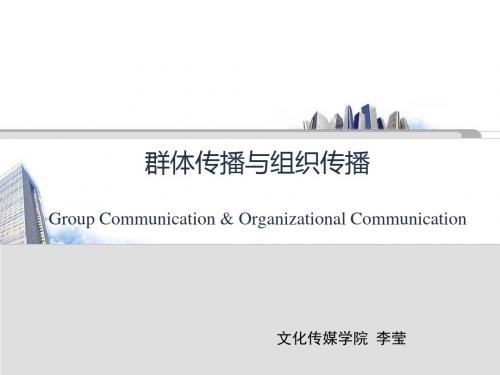
组织内部传播的“4S”策略
• 战略(Strategy):组织应将内部沟通视为管理的一 个战略工具。
• 结构(Structure):沟通渠道的结构和手法。 • 研究(Study):组织内部沟通重在获取资料,掌握
• 产生群体压力的原因或者条件:
• 信息压力
• 趋同心理:指个人的观念或行为由于群体的引导和压
力而产生的一种合群倾向,这种心理使得个体产生 放弃自己与群体意见或规范相抵触的意识倾向。
• 美国社会心理学家所罗门·阿什(Solomon Asch)所 作的“线段实验”(1956)。
集合行为中的传播
• 集合行为(collective behaviour):在某种刺激条 件下发生的非常态社会集合现象。
• 群体暗示:通过间接的示意而非直接说服来使人接 受某种观点或从事某种行为。
• 群体感染:某种观点、情绪或行为在群体暗示机制 的作用下在群体中迅速蔓延。
• 群体模仿:多为无理智、反射性模仿。用常规的方 法很难应付眼前的突然事件,只能基于本能对事件 做出反应。
集合行为中的“信息流”
• 美国社会学家H.布鲁默:集合行为的信息运动方式 是“循环反应”,一方的刺激成为另一方的反应, 而另一方的反应则又反过来成为这一方的刺激的循 环往复过程。
群体意识
• 群体意识:参加群体的成员所共有的意识。
①群体目标和群体规范的合意 ②群体感情 ③群体归属意识
• 群体意识的核心内容:群体规范
• 在群体传播中,群体规范的主要作用是排除偏离性 的意见,将群体内的意见分歧和争论限制在一定范 围内,以保证群体决策和群体活动的效率。
组织传播

组织外传播及其形态
组织外部传播功能 协调组织间关系 创立和维护组织形象 为顾客提供服务 危机处理 组织外传播活动:公关、 广告、CIS
组织环境:在既定的组织存在 的前提下,由各种机构、团 体以及个人组成的更大范围 的环境。 授权型:政府;管理机构; 审查;颁发许可证的单位 功能型:供应商;雇员;职 业中介机构;顾客;财政机 构 规范型:贸易协会;行业组 织;竞争者 普通型:当地社区;媒介组 织;“一般公众” 和谐平稳/动荡不安; 支持性/ 敌对性
人际关系学派(1930s-): 人际关系学派
霍桑实验→社会因素、管理风格、霍桑效应→管理态度转变,工 作丰富化 家庭隐喻(关心、社会互动、个人成就),关系传播(任务性与维持 性,横向,面对面,非正式)
人力资源学派(1960s-): 人力资源学派
满意度和生产效率之间缺乏关联, 人际关系原则的误用, 员工是组织智力和体力的贡献者,是实现组织目标的资源。 团队管理,发展和培养人力资源,全面质量管理, 创新传播(任务、社会与创新,全方位,基本团队,所有渠道,正 式与非正式)
组织中的正式传播
自上而下( 自上而下(downward networks) ) 上行传播( 上行传播(upward communication) ) 横向流动:( 横向流动:(lateral,or horizontal, :( , , communication) )
组织内传播的非正式渠道
作用 1)使成员有归属感、安全感和相互认识。 2)使成员能够公开地、友好地讨论他们所关心的问 题,减轻压力。 3)保持成员的自尊和一定程度的自由。 4)有助于正式的讯息传递。 5)为人际传播和群体传播提供非正式的信息网络。 6)提供社交机会。 7)为管理层的决策提供实际的信息。 8)产生未来的领导者。
- 1、下载文档前请自行甄别文档内容的完整性,平台不提供额外的编辑、内容补充、找答案等附加服务。
- 2、"仅部分预览"的文档,不可在线预览部分如存在完整性等问题,可反馈申请退款(可完整预览的文档不适用该条件!)。
- 3、如文档侵犯您的权益,请联系客服反馈,我们会尽快为您处理(人工客服工作时间:9:00-18:30)。
Blake and Moutons’ Managerial Grid
Concern for people and production Team management 团队型 Authority-compliance 权威-服从型 Country club 乡村俱乐部型 Impoverished 贫乏型 Middle-of-the-road 中庸型
压力和社会支持过程 Emotion 多元化管理过程 Diversity 传播技术过程 Technologies
Part A Founding Approaches
第一部分 基本学派
基本学派之
Classical Approaches
第一章 古典学派
概念
从“员工工作”的角度看待员工 概念导入
主要教学内容: 讲解组织传播的基本概念、特征和过程, 理解组织传播的要素、特点以及不同的模式 介绍西方组织传播学的理论与派别,从传播行为的角度介绍组织与个人的关系、组织与社会环 境互动关系; 解析组织传播过程的成因了解在不同文化背景下的团队合作等模式,形成全球视野 介绍组织传播的理论和方法以及组织传播过程, 对关键概念的阐释配制了模型和图表并附有最 新的案例分析,培养学生运用理论知识探讨显示问题的意识,并检验对理论知识的把握。 介绍当前组织传播的重要主题以及研究文献。
Metaphor 隐喻 Machine 组织的机械隐喻
• Specialization 专业化 • Standardization标准化 • Predictable 可预测性
Fayol 古典管理理论Classical Management
规范性理论,开出药方,而非描述性或解释性 Elements 管理要素
关于本章的Case in point
Invent
Reframing the situation Inventors not as people who are good at solving problems BUT people who are good at finding problems that no one else sees.
Communication in Human Resources Organizations
Classical H.Relations H.Resources
Content
task
Task and social Task, social and innovation maintenance communication Vertical and horizontal All directions, team-based
Maslow需求理论 Hierarchy of Needs Theory
一般性理论 Physiological needs 生理 Safety 安全 Affiliation 归属 Esteem 自尊 Self actualization 自我实现 Hierarchy of prepotency 优先层级
第三章 人力资源学派
概念
把员工视为智力和体力的贡献者,而非能对组 织目标有所贡献的资产(人际关系学派) 是人际关系学派的一种延伸,在动机和方式研 究上与前者有所不同 人际关系学派缺乏实证的支持,工作满足度真 得能提升生产效率吗?(人际关系学派的结论) 概念导入
虚伪性参与 创新传播
The Human Relations Approach in Organizations Today
Impact on Managerial Attitudes
Interchangeable cogs?
Impact on Job Design
Job enrichment
基本学派之
Human Resources Approaches
Power 组织权力原则
•
• •
组织集权 / 权力和责任 / 纪律
人员报酬 / 公平 / 任用稳定:过度任用稳定降低效率 个人利益服从整体利益 / 自发性 / 团队精神
Reward 组织报酬原则 Attitude 组织态度原则
Max Weber 官僚理论 Bureaucracy
学术性理论,Ideal type Clearly defined hierarchy Division of labor 劳动分工 Centralization of decision making and power Closed system Importance of Rules Function of the authority
Likert’s System IV
Exploitive authoritative org. 专权命 令式 Benevolent authoritative org. 温和命 令式 Consultative org. 协商式 Participative org. 参与式 Linking pin 联结枢纽
Planning Organizing Commanding Coordination Control Structure 组织结构原则 Gangplank Faylor’s Bridge
• 等级链 / 统一命令 / 劳动分工 / 秩序 / 控制幅度
ቤተ መጻሕፍቲ ባይዱ
Principles 管理原则
人性假设
• • • • • 人天生懒惰 缺乏野心,不愿负责,愿意受引导 天生自我中心,无视组织 抵制变革 容易受骗
Y理论的假设
工作和游戏一样自然 控制和惩罚不是唯一方法,员工有自我引导自我控制的愿望 自我实现需要的满足 人会学会主动寻求责任 较为丰富的想象力、判断力和创造力普遍存在 人的智慧只得到了部分开发
Ouch’s Theory Z
Adoption of Japanese Management Emphasize the importance of developing and nurturing the human resource Long-term (not lifelong) employment 长期雇佣 Develop company-specific skill 强化训 练与开发 Collective decision making 集体主义
系统学派 Systems 文化学派 Culture 批判学派 Critical
持续过程 Enduring Processes
社会化过程 Assimilation 决策过程 Decision Making 冲突管理过程 Conflict Management
新兴过程 Emerging Processes
Direction
vertical
Channel
Usually written
Often face-toface
informal
All channels
Style
Formal, sterile
Both, but esp. informal
Team Management
Japanese management systems:集体主义 The Scanlon plan: 参与、责任、奖赏 Total Quality Management:员工=内部 客户
Misuse of
Human Relations Principles
Pseudo-participation 虚伪性参与
Human resources are:
Combination of classical and human relations Resources = Changing non-labor human power into productivity
Today’s classical theory
Scalar chain, unity of command, span of control Cross-functional team, matrixing of task One best way is still to be found
Traditional (legitimate) Charismatic Rational-legal
Taylor 科学管理理论 Scientific management
规范性理论,从微观角度探讨组织运作 rate busters高产工人 VS systematic soldiering群体磨洋工 & uneven work参 差不齐工作量 Best way to do Proper selection of workers Training workers: time and motion studies Inherent difference between management and workers
Why Human Resources Approach?
Human Relations Principles Don’t Work
Satisfaction of Higher-order Needs → Work satisfaction → motivation → (?) productivity
基本学派之
Human Relations Approaches
第二章 人际关系学派
概念
从“员工感觉”的角度看待员工 概念导入
Hawthorne studies & Hawthorne effect social presence job enrichment 组织的家庭隐喻:需要得到满足和有机会实现 自我时才能发展
Herzberg激励-保健理论 Motivation-Hygiene Theory
可运用的理论 Motivation present: Happy Hygiene present: Not Unhappy
